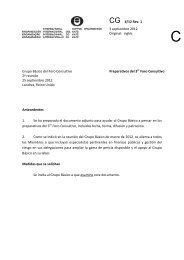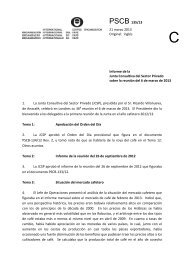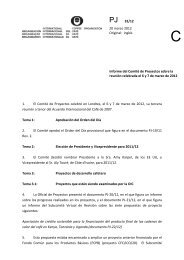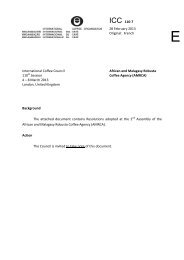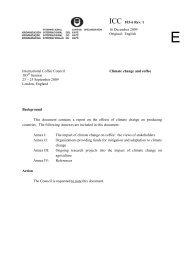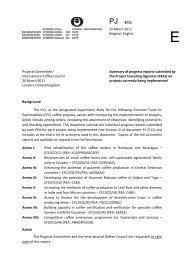Devouring profit - International Coffee Organization
Devouring profit - International Coffee Organization
Devouring profit - International Coffee Organization
You also want an ePaper? Increase the reach of your titles
YUMPU automatically turns print PDFs into web optimized ePapers that Google loves.
This appendix reviews the economic importance of coffee in six countries, as a contributor<br />
to GDP, exports and as a generator of foreign exchange.<br />
<strong>Coffee</strong> production has increased in most of the countries studied, most notably in the<br />
1970s and 80s with the advent of new varieties and production subsidies. Surprisingly<br />
though, yields are still poor in many parts of all countries. This is because coffee is still<br />
produced by a large number of smallholders who have mostly not benefited from the<br />
technology on offer.<br />
In all the six countries, coffee is of declining economic significance, both as a percentage<br />
of GDP and of foreign earnings, a circumstance that is a natural consequence of<br />
the development of their mostly city-based industries. But if we take into account its<br />
continuing importance as a generator of employment, coffee’s importance remains<br />
mostly unchanged. From this we conclude that coffee is now of more social significance<br />
than pure economics may suggest. Thus a recent report (Ramírez et al., 2002),<br />
analysing the coffee institutions of Colombia, states that the coffee sector has developed<br />
into a social issue of very high importance which has a role in national stability.<br />
Indeed because of the secular decline of agriculture, coffee may now be more important<br />
than previously, for when it suffers a downturn there are few alternatives for<br />
members of this already depressed rural sector. We believe that such societal externalities<br />
must lead to hidden extra costs that are still to be calculated but which are<br />
beyond the scope of this book. We merely note that of the six countries studied, four<br />
have faced significant rural-based guerrilla activities in recent years, all of which have<br />
included coffee-growing zones.<br />
India<br />
The agricultural sector contributes 25% of the country’s GDP although this participation<br />
is declining. E.g. in 1947, 85% of the population depended on agriculture, which<br />
contributed to 70% of the Indian GDP; currently 75% of the population still depend on<br />
agriculture. The main agricultural products are rice, wheat, oilseed, cotton, jute, tea,<br />
coffee, sugarcane, potatoes, and a range of livestock. Coconut, cashew nuts, and<br />
vegetables are also important.<br />
Agricultural exports have fluctuated between 12 and 20% of total exports, though in<br />
dollar terms they remain relatively constant, suggesting a gradual transition from a<br />
predominantly agricultural production base to a broad-spectrum of industry and services.<br />
The major agricultural exports are cereals, spices, cashew, oilcake/meal, tobacco,<br />
tea, coffee, and marine products. <strong>Coffee</strong> exports have remained above US$400 million<br />
over recent years with the exception of 1999-2000 (US$315 million) and 2000-<br />
01.<br />
Menon (2001) points out that the fall in international prices of robusta coffee as well as<br />
pepper has adversely affected the coffee farmers from Karnataka and Kerala states.<br />
Pepper is an important extra income for many coffee farmers but its productivity has<br />
been low (275–300 kg/ha). Additionally the price has seen reductions from Rs 22,600/<br />
97





